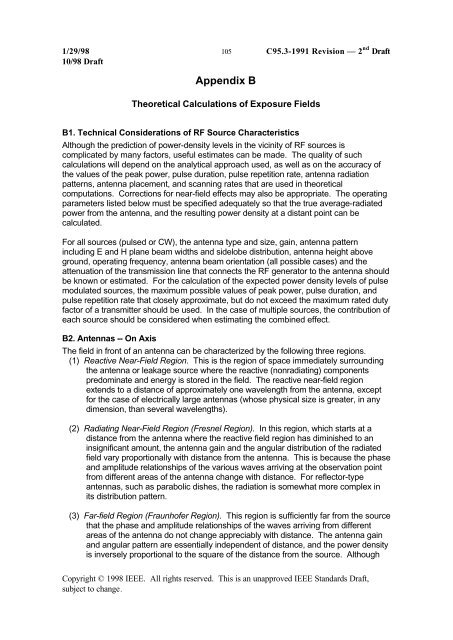DRAFT Recommended Practice for Measurements and ...
DRAFT Recommended Practice for Measurements and ...
DRAFT Recommended Practice for Measurements and ...
You also want an ePaper? Increase the reach of your titles
YUMPU automatically turns print PDFs into web optimized ePapers that Google loves.
1/29/98 105 C95.3-1991 Revision — 2 nd Draft<br />
10/98 Draft<br />
Appendix B<br />
Theoretical Calculations of Exposure Fields<br />
B1. Technical Considerations of RF Source Characteristics<br />
Although the prediction of power-density levels in the vicinity of RF sources is<br />
complicated by many factors, useful estimates can be made. The quality of such<br />
calculations will depend on the analytical approach used, as well as on the accuracy of<br />
the values of the peak power, pulse duration, pulse repetition rate, antenna radiation<br />
patterns, antenna placement, <strong>and</strong> scanning rates that are used in theoretical<br />
computations. Corrections <strong>for</strong> near-field effects may also be appropriate. The operating<br />
parameters listed below must be specified adequately so that the true average-radiated<br />
power from the antenna, <strong>and</strong> the resulting power density at a distant point can be<br />
calculated.<br />
For all sources (pulsed or CW), the antenna type <strong>and</strong> size, gain, antenna pattern<br />
including E <strong>and</strong> H plane beam widths <strong>and</strong> sidelobe distribution, antenna height above<br />
ground, operating frequency, antenna beam orientation (all possible cases) <strong>and</strong> the<br />
attenuation of the transmission line that connects the RF generator to the antenna should<br />
be known or estimated. For the calculation of the expected power density levels of pulse<br />
modulated sources, the maximum possible values of peak power, pulse duration, <strong>and</strong><br />
pulse repetition rate that closely approximate, but do not exceed the maximum rated duty<br />
factor of a transmitter should be used. In the case of multiple sources, the contribution of<br />
each source should be considered when estimating the combined effect.<br />
B2. Antennas -- On Axis<br />
The field in front of an antenna can be characterized by the following three regions.<br />
(1) Reactive Near-Field Region. This is the region of space immediately surrounding<br />
the antenna or leakage source where the reactive (nonradiating) components<br />
predominate <strong>and</strong> energy is stored in the field. The reactive near-field region<br />
extends to a distance of approximately one wavelength from the antenna, except<br />
<strong>for</strong> the case of electrically large antennas (whose physical size is greater, in any<br />
dimension, than several wavelengths).<br />
(2) Radiating Near-Field Region (Fresnel Region). In this region, which starts at a<br />
distance from the antenna where the reactive field region has diminished to an<br />
insignificant amount, the antenna gain <strong>and</strong> the angular distribution of the radiated<br />
field vary proportionally with distance from the antenna. This is because the phase<br />
<strong>and</strong> amplitude relationships of the various waves arriving at the observation point<br />
from different areas of the antenna change with distance. For reflector-type<br />
antennas, such as parabolic dishes, the radiation is somewhat more complex in<br />
its distribution pattern.<br />
(3) Far-field Region (Fraunhofer Region). This region is sufficiently far from the source<br />
that the phase <strong>and</strong> amplitude relationships of the waves arriving from different<br />
areas of the antenna do not change appreciably with distance. The antenna gain<br />
<strong>and</strong> angular pattern are essentially independent of distance, <strong>and</strong> the power density<br />
is inversely proportional to the square of the distance from the source. Although<br />
Copyright © 1998 IEEE. All rights reserved. This is an unapproved IEEE St<strong>and</strong>ards Draft,<br />
subject to change.
















